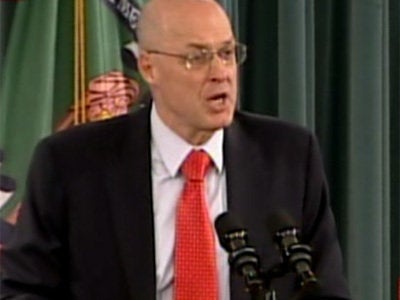
So, $290 billion into his bailout plan, Hank Paulson is calling for a do-over. Now there is a confidence booster.
Providing "I-told-you-so" talking points to the what's-the-rush crowd, the Secretary of the Treasury announced yesterday that the government is no longer going to use any of the $700 billion Congress allocated to the Troubled Asset Relief Program (TARP) to buy, well, Troubled Assets from financial institutions -- the original centerpiece of the plan.
Instead, Paulson is looking to fortify the financial industry by continuing to buy premium stock in banks (aka the Warren Buffett approach). Unfortunately, instead of sending Paulson a thank you note in the form of increased consumer lending, the banks are depositing the government checks and taking a wait and see approach. (Among the things they've seen: another $40 billion handed over to AIG.)
This is not to say that Paulson's midstream direction change is a bad thing -- indeed, the lip service he's now paying to putting the focus on consumers is encouraging -- but it shows just how uncertain official Washington is about how to keep the economy from imploding.
In the meantime, oversight of the massive bailout plan remains a mirage -- undermined by White House inaction and Congressional turf wars.
Remember all the promises that the $700 billion in taxpayer money would be closely supervised? No blank checks here, we were told. A special inspector general was going to be picked by the White House and Congress was going to hand-select an oversight panel.
But despite over a quarter of a trillion dollars having already been doled out by Paulson, so far both the inspector general position and the five Congressional Oversight Panel slots remain unfilled.
The White House appears ready to nominate New York prosecutor Neil Barofky as inspector general, though it's up in the air how quickly Congress would confirm him (if they confirm him at all). Among the looming issues, a squabble between the Senate Banking Committee and the Senate Finance Committee over which would have control of the confirmation process.
"It's a mess," said Eric Thorson, the Treasury Department's inspector general, who has been doing fill-in oversight duty until the special inspector general is confirmed. "I don't think anyone understands right now how we're going to do proper oversight of this thing."
Bartender, another round of lack of confidence for everyone.
Unfortunately, while Paulson waffles, the White House dawdles, and Congress dithers, the economy continues to burn.
The number of Americans filing new claims for unemployment last week -- 516,000 -- was the most since September 2001, in the wake of 9/11. And the number of people continuing to collect unemployment -- 3,897,000 -- was the highest it's been in 25 years.
"The labor market is deteriorating more rapidly than previously thought," Andrew Gledhill, economist at Moody's Economy.com, told CNNMoney.
In the past week, Ford said it would cut salaried employment costs by 10 percent, global delivery company DHL said it was cutting 9,500 jobs and financial service provider Fidelity Investment announced 1,300 job cuts. The list goes on and on: Circuit City, Pizza Hut, Morgan Stanley, Condé Nast, Yahoo, US Steel, Cesna, and QVC.
According to the Department of Labor, 240,000 jobs were lost in October, bringing the total of 2008 pink slips to 1.2 million. The unemployment rate is 6.5 percent, the highest it's been in 14 years.
On the housing front, another 84,868 homes were lost to foreclosure in October; there have been 936,439 home foreclosures since August 2007. And the housing future continues to look bleak: in October, 279,561 borrowers received at least one foreclosure-related notice, including default notices, notices of auction sales and bank repossessions, according to RealtyTrac. One in every 452 housing units received one of these. Nevada, Arizona, and Florida had the country's top three foreclosure rates.
Despite the carnage in the housing market, the White House continues to offer what the New York Times labeled "pathetic responses" and inadequate "half measures." And much-discussed legislation allowing bankrupt homeowners to rework their mortgages in court remains in a holding pattern, awaiting action from the lame duck Congress. I wouldn't hold my breath.
January 20th cannot arrive fast enough for the American people.
